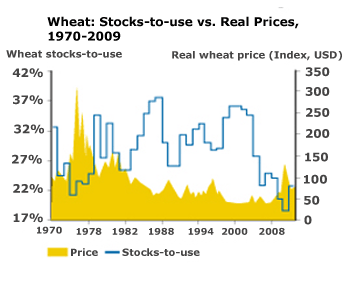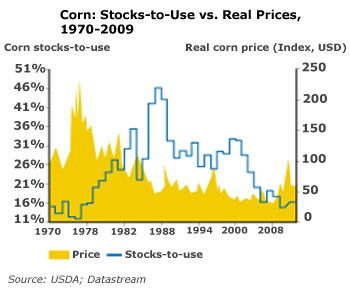| Home | About Us | Resources | Archive | Free Reports | Market Window |
The Biggest Reason to Get Excited About Investing in AgricultureBy
Wednesday, May 20, 2009
There is some mind-bending stuff percolating in the agricultural markets. In fact, the setting recalls the one that set off the big move in oil prices in recent years...
"Investing in agriculture today will be like investing in the oil sector in 2001-2002," writes Mark McLornan in the May issue of Marc Faber's Gloom Boom & Doom Report. McLornan runs a fund that invests in farmland. Some of his on-the-ground observations confirm many of the things I've been telling my readers for the past several years. As for likening agriculture today to oil in 2001-2002, an investor's pulse quickens. We all know the great run oil stocks had as the price of oil sprinted from under $30 to a peak of $143 per barrel. Investors made hundreds-of-percent gains – even thousands-of-percent gains. What most investors forget is that oil prices halved from 2000 to the bottom in 2001 before the great run-up. The same sort of setup seems to exist in agriculture. In agriculture, most commodities are half or so of their June 2008 highs. This is the pause that refreshes. All the kindling that turned them ablaze in 2008 – rice was trading for $1,000 per ton –are still in place for a much bigger surge this time around. "I believe one should look for areas in which there is underinvestment, low leverage and undersupply," McLornan continues. "Agriculture is one of the very few sectors globally that currently face supply shortages." The biggest reason to get excited about agriculture is to look at the stocks-to-use ratio, which measures how much supply is on hand versus how much we use. Higher ratios imply a fully supplied market. Lower ratios hint at possible shortages. McLornan provides two charts that show how the stocks-to-use ratios look for wheat and corn, respectively.
Those ratios today are lean. You have to go back to the 1970s to find inventories this low. The kicker to all this is that last year, we had a record crop and the stocks-to-use ratio barely budged. There is no way we are going to top that harvest this year with all the drought hitting different parts of the world. In fact, the International Grains Council (IGC) predicts a fall in total wheat output in 2009-10. The IGC predicts global wheat output of 650 million tons, down by 5% from the previous year. The largest declines are seen in the European Union, the U.S., China, Russia, and Ukraine. "Although conditions in the Northern Hemisphere are generally favorable," the IGC says, "production is likely to fall sharply." There is other ancillary evidence that we can't meaningfully boost crop yields easily at this point, either. China has the highest levels of fertilizer use in the world and its crop yields are still not even average. McLornan says that global yields for wheat hit a plateau in the 1980s and "gene modification technology has been unable to improve what natural selection has achieved over the past centuries." So we already have tight supplies. And they look to get tighter. What about demand? Demand for grains is not likely to fall. Population growth is the biggest driver. Globally, between 2000-2012, we'll add some billion people to the world's population. "Coincidentally," McLornan writes, "2000 was the year in which global grain stocks peaked and then began their rapid decline." Dietary patterns also have a big impact on grains. As more people eat meat, as the increasingly wealthy Chinese are doing, the pull on grains for livestock goes up exponentially. The USDA projects global consumption of wheat will increase 6% in 2009, with a large part of this as feed wheat to cattle. Adding to the impending crisis is the insistence of governments around the world to prop up biofuels. This puts the production of food in direct competition with the production of energy. Just when we need all that acreage for food, we've got acres of, say, corn for ethanol. There is even talk of raising the ethanol blend from its current 10% to 15%. So while the economics of making ethanol are abysmal right now, it seems the ethanol industry still has government in its back pocket. I think we're getting close to when all of this becomes front-page news. We have another few months before the reality of a lousy fall harvest sets in. Agriculture stocks should do very well from that point – for everything from fertilizer stocks like Potash (POT) to agricultural equipment makers to the grains themselves. As always, I recommend buying assets like these before the crowd sees it on the news. Good investing, Chris Mayer P.S. I've recommended a handful of the top agriculture investments to myMayer's Special Situations readers. Actually, our portfolio is loaded with real asset investments that will soar as investors flock to "wealth preservers" like mines, farmland, and energy. You can click here to learn more about these ideas.
Further Reading:
My Top Inflation-Fighting Stock Ideas Market NotesIT'S A JIM ROGERS-APPROVED BULL MARKET
If you've listened to legendary investor Jim Rogers in the past few months, you know the guy loves agriculture right now.
Jim points out that growing Asian demand and low inventories will create a long bull market in ag products like corn, soybeans, and fertilizer. He even went so far as to issue marriage advice based on his belief: He says marry a farmer instead of an investment banker. Farmers are the guys who will get filthy rich over the coming years. So how does Jim's top idea look from the "big trend" perspective? Pretty good... Below is a chart of the PowerShares Agriculture ETF (DBA). This is one of the largest and most liquid ways to trade agriculture through the stock market. It divides its holdings evenly between corn, soybeans, wheat, and sugar. As you can see, grains were clobbered during the great washout of 2008. But after striking a hard bottom in December, the grains are slowly and surely setting a series of "higher highs and higher lows." It's bullish action from this Jim Rogers-approved asset. |
In The Daily Crux
Recent Articles
|



